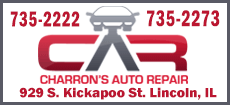What’s in Illinois' $46 billion budget package?
 Send a link to a friend
Send a link to a friend
[April 20, 2022] By
PETER HANCOCK
Capitol News Illinois
phancock@capitolnewsillinois.com
 SPRINGFIELD – Gov. JB Pritzker signed a
package of bills Tuesday that make up a roughly $46 billion Fiscal Year
2023 state general revenue funds budget that includes increased funding
for education and human services and $1.8 billion in mostly-temporary
tax relief. SPRINGFIELD – Gov. JB Pritzker signed a
package of bills Tuesday that make up a roughly $46 billion Fiscal Year
2023 state general revenue funds budget that includes increased funding
for education and human services and $1.8 billion in mostly-temporary
tax relief.
Pritzker signed the bill during a ceremony at Chicago State University
where he was joined by students who stand to benefit from increased
funding for higher education, including more money for student financial
aid through the state’s Monetary Award Program.
“The budget increases investment in MAP and provide increased
opportunity for our students to access complete a college education
right here in our great state of Illinois,” said CSU president
Zaldwaynaka "Z" Scott. “The dividends of this investment will not only
yield our state immediate benefits but will impact families for
generations to come.”
In total, the spending plan appropriates $115 billion for all funds,
with the $46 billion accounting for the state’s main discretionary
general revenue funds.

The budget is based on estimated GRF revenue of about $46.5 billion,
which would leave the state with a budget surplus of $444 million at the
end of the year, the second consecutive budget surplus under the
Pritzker administration.
The budget signed Tuesday directed $720 million into the state’s Budget
Stabilization Fund from the current fiscal year and $280 million out of
next year’s revenues – the first such deposits made into that fund in 18
years.
“We're putting a billion dollars into the state's rainy day fund so that
we won't have so many troubles the next time hard times hit our state,”
Pritzker said. “And we put an extra $500 million into our pensions,
saving taxpayers nearly $2 billion in future interest payments, and to
make sure retirees get what they are owed. Balancing the budget allows
us to save for the future and live up to our financial obligations.”
Tax relief
The tax relief package was one of the most hotly debated elements of the
budget, both between Democrats and Republicans and within the Democratic
caucus itself.
The final agreement includes $520 million for a one-time property tax
rebate for qualifying homeowners. The rebate would be equal to 5 percent
of the homeowner’s tax bill, up to a maximum of $300.
It also provides for a one-time income tax rebate of $50 per individual
and $100 per dependent, up to a limit of three children per family, for
individuals with incomes up to $200,000 and joint filers with incomes up
to $400,000.
The package also calls for a one-year suspension of the state’s 1
percent tax on groceries. That’s about $400 million in revenue that
would normally go to local units of government but which the state will
pay out of its own general revenue funds for one year.
It also puts a six-month pause on the automatic inflationary increase in
the state’s motor fuel tax, which was estimated to be 2.2 cents per
gallon, or about $70 million over that period. That money would normally
go into a fund for road and bridge projects but the state will make up
for that loss by transferring money from its Leaking Underground Storage
Tank Fund.

Another $50 million in tax relief will come in the form of a
back-to-school sales tax holiday on clothing and school supplies for 10
days in August and a doubling of the tax credit that teachers can claim
for buying school supplies for their students.
The one permanent element of the tax relief plan expands the state
earned income tax credit from 18 to 20 percent of the federal credit
while also expanding the number of households that can claim the credit.
Education
Overall, the budget calls for spending $12 billion on education next
year, or 26 percent of the total operating budget. That includes just
under $9.8 billion for PreK-12 education and $2.2 billion for higher
education.
The PreK-12 budget includes the statutory $350.2 million increase called
for in the Evidence Based Funding formula that lawmakers approved in
2017.
In addition, the budget provides a $96 million increase for
transportation and special education reimbursements to school districts,
a $54.4 million increase for early childhood education and $300 million
in grants to child care providers.
The higher education budget includes supplemental appropriations in the
current fiscal year of 5 percent over what lawmakers approved last
spring and a continuation of that increase into the next fiscal year.
It provides an additional $122 million in funding for MAP grants, the
state’s need-based financial aid program, bringing the total available
next year to $601.5 million. It also provides an expansion of the
maximum award to 50 percent of tuition at public universities and
coverage for an additional 24,000 students.

“With funding from the MAP grant, students will not only earn a degree
without accumulating debt, but (will have) access to better
opportunities and greater social capital,” said Nekoiya Washington, a
CSU senior and MAP grant recipient.
Public safety
The Illinois State Police will be able to recruit as many as 300 new
officers in the upcoming year with funding for an additional class of
cadets, the largest dollar investment in state history to expand cadet
classes
[to top of second column]
|


The budget package also includes more than $1.4 billion from a variety
of different funds for other projects aimed at reducing crime and
violence in the state. Those include:
Approximately $1 billion for violence prevention, youth employment, and
diversion programs.
A $50 million increase directly from marijuana revenues to support
communities harmed by violence, excessive incarceration and economic
disinvestment.
$240 million for the Reimagine Public Safety Act aimed at early violence
intervention, including $235 million in federal American Rescue Plan Act
funding.
$30 million to support the Violent Crime Witness Protection Program.
$20 million for grants to non-profits for security investments to
prepare for hate crimes.
$30 million for Local Law Enforcement Body Camera grants.
$20 million for less lethal device grants and associated training
expenses.
$10 million for a mental health co-responder pilot program.
$10 million for a local law enforcement retention grant program.
$8 million for a multi-year equipment replacement program at the
Illinois State Police that includes radios, body and car cameras, and
cloud storage.
$5.4 million for increased staffing and equipment at a new ISP forensic
lab in Decatur.
And $20 million for cameras and automatic license plate readers on state
highways.
Health and social services
Health care services, most of which are provided through the state’s
Medicaid program, typically make up about 17 percent of state spending
while other human services such as foster care and care for people with
disabilities make up about 18 percent.

One of the biggest new health care programs provided in the budget is a
$700 million increase in reimbursements for Medicaid-funded Nursing
homes through a new payment model lawmakers approved in March that is
aimed at increasing staffing levels at those facilities.
Other highlights of the health care budget include a $230 million
increase in funding for mental health care and community-based substance
abuse treatment providers; $150 million to fully implement the Pathways
to Success Program for children with serious mental illnesses; and $70
million to implement the 9-8-8 call center and crisis response for
people experiencing mental health crises.
The budget also establishes a framework for distributing the first year
of funding from Illinois’ share of a $26 billion national opioid
settlement agreement.
The human services budget includes a $250 million increase for the
Department of Children and Family Services to hire additional staff and
increase reimbursement rates to outside child welfare agencies that
contract with the department.
Economic development
Among the new economic initiatives in the budget is a one-year waiver of
retail liquor license fees, a move intended to aid restaurants, bars and
other liquor license holders that were hard hit by the COVID-19
pandemic.
The budget package also includes a permanent increase in the state’s
revenue sharing formula that will bring an additional $25 million in
funding to local units of government through the Local Government
Distributive Fund.
There is also funding for a variety of job training programs, business
attraction and retention programs and $55 million in capital funding to
promote economic development throughout the state, including funds to
support zero emission vehicle manufacturing, clean energy, supply chain
manufacturing and other environmental purposes.

ARPA funds
The budget package also appropriates the remaining $4 billion in federal
American Rescue Plan Act funding. That includes the $2.7 billion that
was used in March to pay down part of the deficit in the state’s
Unemployment Insurance Trust Fund.
The remaining $1.37 billion includes:
$320 million for Illinois Emergency Management Agency, Department of
Corrections, Department of Human Services and Department of Public
Health.
$380 million in pandemic support for health care provider payments.
$150 million for affordable housing programs through the Illinois
Housing Development Authority.
$83.4 million for violence prevention and interruption grants at
Criminal Justice Information Authority.
And $190 million in other support through the Department of Commerce and
Economic Opportunity, including $75 million for the hotel industry, $50
million for restaurants and bars, $50 million for arts-related grants,
and $15 million for tourism attraction development grants
Capitol News Illinois is a nonprofit, nonpartisan news service covering
state government and distributed to more than 400 newspapers statewide.
It is funded primarily by the Illinois Press Foundation and the Robert
R. McCormick Foundation.
 |